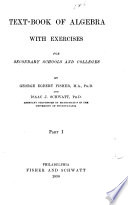 | George Egbert Fisher, Isaac Joachim Schwatt - Algebra - 1898 - 712 pages
...preceding article is derived the following principle for multiplying a multinomial by a multinomial: Multiply each term of the multiplicand by each term of the multiplier, and add algebraically the resulting products. Ex. l. Multiply -3a + 2& by 2a-36. We have -36x26 (1)... | |
 | Seymour Eaton - 1899 - 362 pages
...Lesson No. 9. Algebraic Multiplication (Continued) To multiply one compound expression by another, multiply each term of the multiplicand by each term of the multiplier, and add results for the complete answer. To find the product of a + b and c + d. (o+6) x(c + d) = (a... | |
 | William J. Milne - Algebra - 1899 - 172 pages
...+ b a times a + 6 = a'2 + a6 6 times a + b = ab + Ift (a + 6) times (a + 6) = a2 + 2 ab + 6" RULE. Multiply each term of the multiplicand by each term of the multiplier, and add the partial products. 2. 3. 2 ab - 3 ca? x — y ;26'2- lOa6c-Sc2 & Multiply : 4. x + ybyx... | |
 | 1900 - 594 pages
...amount willed to his two children. $125000 = amount willed to his wife and two children. 710 5 5 = amount willed to his two children. $53945 = amount...under the term of the multiplier which produces it. (-1) 7x7 units = 49 units, or 4 tens and 9 526387 units. We write the 9 units and reserve 7 the 4 tens.... | |
 | James Morford Taylor - Algebra - 1900 - 504 pages
...22. 2\3ab-4:a(c-2b')l. 23. 7ac-2{2c(a-3&)-3(5c-2Z»)a|. 79. To multiply one polynomial by another, Multiply each term of the multiplicand by each term of the multiplier, and add the resulting products. Proof. Let x + y + z be the multiplicand, and a + b the multiplier... | |
 | George Egbert Fisher, Isaac Joachim Schwatt - Algebra - 1900 - 202 pages
...3x7-3x5. This example illustrates the following method of multiplying a multinomial by a multinomial : Multiply each term of the multiplicand by each term of the multiplier, and add algebraically the resulting products. In general, (a + 6)(c + d- e) = a(c + d- e) + b(c + d-... | |
 | George Edward Atwood - 1900 - 276 pages
...a polynomial. RULE. — Arrange the multiplicand and multiplier with reference to the same letter. Multiply each term of the multiplicand by each term of the multiplier, and add the partial products. EXAMPLES. 2- 3a263+ 2o64 +26* b3 — 6a464+ - 8a464+ a —b +2 c +x -3... | |
 | George Egbert Fisher, Isaac Joachim Schwatt - Algebra - 1900 - 484 pages
...3x7-3x5. This example illustrates the following method of multiplying a multinomial by a multinomial : Multiply each term of the multiplicand by each term of the multiplier, and add algebraically the resulting products. In general, (a + 6) (c + d - в) — a (c + d - e) +... | |
 | Boring - 1901 - 552 pages
...the smaller number (5,913) from the greater (23,456) we have 23456 5913 17543 difference. Ans. (12) In the multiplication of whole numbers, place the...multiplicand by each term of the multiplier, writing 5. Vol. I.—3>. the right-hand figure of each product obtained under the term of the multiplier which... | |
 | George Egbert Fisher - 1901 - 622 pages
...3x7-3x5. This example illustrates the following method of multiplying a multinomial by a multinomial : Multiply each term of the multiplicand by each term of the multiplier, and add algebraically the resulting products. In general, (a + *)(c + </- e) = a(c + d- e) + b(c +... | |
| |